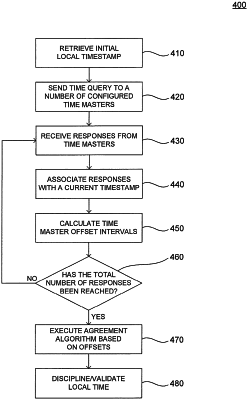| CPC G06F 1/12 (2013.01) [G01S 19/01 (2013.01); H04J 3/0661 (2013.01); H04J 3/0667 (2013.01); H04L 7/0008 (2013.01); H04L 7/0012 (2013.01); H04L 7/0016 (2013.01); H04L 43/106 (2013.01); H04L 67/10 (2013.01); G06F 11/1675 (2013.01)] | 17 Claims |

|
1. A method for synchronizing a host machine, comprising:
receiving an initial local timestamp;
receiving response timestamps transmitted from a first group of time masters and a second group of time masters, the second group of time masters configured differently than the first group of time masters with respect to connection to a reliable source of time, each response timestamp associated with a current local timestamp;
calculating, using a processor, time offset intervals for the first group of time masters based on the initial local timestamp and the response timestamps of the first group of time masters;
calculating, using the processor, time offset intervals for the second group of time masters based on the initial local timestamp and the response timestamps of the second group of time masters;
determining, using the processor, an agreement based smallest time offset interval consistent among both groups of time masters; and
adjusting, using the processor, a local clock on the host machine based on the agreement based smallest time offset interval consistent among both groups of time masters.
|